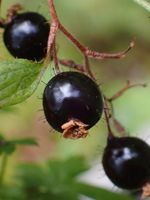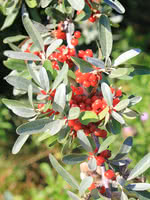Mon-Fri 9am - 5pm Mountain time
Silver Buffalo Berry vs Bristly Black Currant
Ribes lacustre
Shepherdia argentea
CUSTOM GROW
Bristly Black Currant is a native deciduous shrub that grows in moist forests, swamps, and riparian areas. In summer, it produces clusters of dark purple to black berries that provide food for wildlife, while its reddish-purple flowers attract pollinators. The berries are technically edible and enjoyed by some, but many find them unpleasant and bitter.
Thriving in moist soils and shaded locations, Bristly Black Currant helps stabilize soil and supports diverse habitats. It is valuable for conservation plantings, wetland restoration, riparian buffers, and naturalization projects.
Note: When crushed, the berries are known to release an offensive odour.
Silver Buffalo Berry is a cold hardy, ornamental shrub that is commonly used in the first row of shelterbelts instead of caragana or lilac. It features subtle yellow flowers, smooth grey bark, and red fruit. On occasion orange fruit is produced and rarely a yellow fruit. Please note: we regularly collect the rare yellow and orange fruit to use for our seed source.
Long-lived and slow growing, Silver Buffalo Berry is commonly found around sloughs, in coulees, and on light soils across the prairies, and grows best in full sun.
Buyers can enjoy increased bird life to their property, as this shrub acts as a habitat plant. It is also commonly planted for its ornamental and winter interest. It is native to parts of central and western North America.
This species is also known as one of the more salt-tolerant species for those with saline soils.
Note: this berry has mixed reviews when fresh, but makes a desirable jam or jelly with what is described as a clove and pear taste.
Bristly Black Currant Quick Facts
Silver Buffalo Berry Quick Facts
Toxicity: prickles may cause an allergic reaction
In row spacing: 0.9 - 1.2 m (3 - 4 ft)

